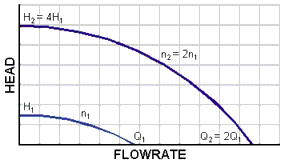Pump Theory
Pumps are an integral part of many pressure systems. Pumps add energy, or head gains, to the flow to counteract headlosses and hydraulic grade differences within the system.
A pump is defined by its characteristic curve, which relates the pump head, or the head added to the system, to the flow rate. This curve is indicative of the ability of the pump to add head at different flow rates. To model behavior of the pump system, additional information is needed to ascertain the actual point at which the pump will be operating.
The system operating point is based on the point at which the pump curve crosses the system curve representing the static lift and headlosses due to friction and minor losses. When these curves are superimposed, the operating point can easily be found. This is shown in the figure below.

System Operating Point
As water surface elevations and demands throughout the system change, the static head (Hs) and headlosses (HL) vary. This changes the location of the system curve, while the pump charactheristic curve remains constant. These shifts in the system curve result in a shifting operating point over time.
Variable Speed Pumps
A pump's characteristic curve is fixed for a given motor speed and impeller diameter, but can be determined for any speed and any diameter by applying the affinity laws. For variable speed pumps, these affinity laws are presented as:
and
Effect of Relative Speed on Pump Curve
Constant Horsepower Pumps
During preliminary studies, the exact characteristics of the constant horsepower pump may not be known. In these cases, the assumption is often made that the pump is adding energy to the water at a constant rate. Based on power-head-flow rate relationships for the pumps, the operating point of the pump can then be determined. Although this assumption is useful for some applications, a constant horsepower pump should only be used for preliminary studies.
This software currently models six different types of pumps:
- Constant Power-These pumps may be useful for preliminary designs and estimating pump size, but should not be used for any analysis for which more accurate results are desired.
- Design Point (One-Point)-A pump can be defined by a single design point (Hd @ Qd). From this point, the curve's interception with the head and discharge axes is computed as Ho = 1.33·Hd and Qo = 2.00·Qd. This type of pump is useful for preliminary designs but should not be used for final analysis.
- Standard (Three-Point)-This pump curve is defined by three points-the shutoff head (pump head at zero discharge), the design point (as with the single-point pump), and the maximum operating point (the highest discharge at which the pump performs predictably).
- Standard Extended-The same as the standard three-point pump but with an extended point at the zero pump head point. This is automatically calculated by the program.
- Custom Extended-The custom extended pump is similar to the standard extended pump, but allows you to enter the discharge at zero pump head.
- Multiple Point-This option allows you to define a custom rating curve for a pump. The pump curve is defined by entering points for discharge rates at various heads. Since the general pump equation, shown below, is used to simulate the pump during the network computations, the user-defined pump curve points are used to solve for coefficients in the general pump equation:
The Levenberg-Marquardt Method is used to solve for A, B and C based on the given multiple-point rating curve.




